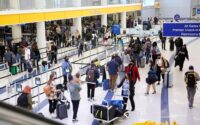Airport security will soon be ‘like fast food kiosks’ with self-service screening
Say goodbye to the TSA pat down.
Airports nationwide plan to install self-checkout-style security lines after testing the new technology in Las Vegas next month.
The program will allow PreCheck passengers to complete the screening process with minimal to no assistance from transportation security officers (TSOs).
The Transportation Security Administration (TSA) partnered with the Science and Technology Directorate (S&T) to create several options for passengers to seamlessly scan their IDs, carry-on bags and bodies before walking to their gate.
“Like self-ordering kiosks at fast food and sit-down restaurants, self-service screening allows passengers in the Trusted Traveler Program to complete the security screening process on their own,” Screening at Speed Program Manager Dr. John Fortune said in a statement.
“Travelers will use passenger and carry-on screening systems at individual consoles or screening lanes themselves, reducing the number of pat-downs and bag inspections TSOs need to perform and freeing their time to be reallocated to the busier aspects of screening operations.”
Tech companies Micro-X, Vanderlande Industries Inc. and Voxel Radar are working to each develop their own self-screening concepts that comply with TSA security regulations while streamlining the process and minimizing person-to-person contact.
The different systems are all intended to allow passengers to set their own pace, keep the line moving and free TSOs to focus on higher security risks.
Micro-X is developing a pod-based design that will allow travelers to step through individual consoles and alert them when additional screening is required.
The technology company is also developing a small Computed Tomography (CT) X-ray system for compact carry-ons and personal item self-screenings that won’t require passengers to remove their liquids or electronics.
Vanderlane has created four integrated stations for one checkpoint lane combining carry-on bag conveyor lines utilizing CT x-rays with automated screening portals which will have automated entry and exit points.
Each station will have a video monitor with multi-step instructions, notifications for passengers who forget items in their pockets and a help button to alert security officers for assistance as needed.
Meanwhile, Voxel Radar is creating a prototype with in-motion sensors to allow passengers to be screened in real-time as they remove their belongings and walk through the checkpoint to keep lines moving.
“A lot of these technologies allow the passenger to be more in control of their own journey through the checkpoint and be more self-sufficient without necessarily having to interact with an officer,” T.J. Schulz, president of the Airport Consultants Council, an association that represents airport development companies, told The Washington Post.
“This continues a trend of allowing the passenger to be self-reliant through the checkpoint and is very much in alignment with the whole airline travel passenger experience.”
The technologies are similar to other recent security updates including the Delta Digital ID and Global Entry processes which allow travelers to quickly walk through security after looking into a camera and getting their face scanned.
Vanderlane’s prototype was installed at Ronald Reagan Washington National Airport in Washington, D.C. in March 2023 for simulated system tests which received “incredibly positive” feedback, Dr. Fortune claimed.
Experts warn that there will be a learning curve for all passengers but are mostly concerned with the costs.
“The big challenge for TSA is money,” Schulz warned. “They just don’t have the money to fully develop and deploy these advanced technologies.”
However, the TSA has announced that Vaderlane stations will be opened to the public for the first time at Harry Reid International Airport in Las Vegas, Nevada in January and the Micro-X self-screening system is scheduled to be tested in 2025.
“The airport security experience that we’ve all come to know could soon look and feel a lot different — in a very good way — for both passengers and TSOs,” Christina Peach, branch manager for the TSA Innovation Task Force said in a statement.


